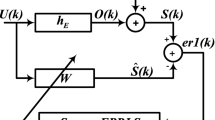Abstract
The proposed beamforming model exploits the underlying sparseness of the adaptive filter as impulse response of wireless channel shows some extent of sparse behavior in practice. A new formulation of cost function of fourth order instead of quadratic will help to achieve stable and faster convergence, but the computational complexity is high. Thus the filter design requires a compromise between the quadratic and fourth order cost function to achieve good estimation accuracy. Normalized least mean square fourth (NLMS/F) filter design is based on the compromise to achieve a better performance with a faster convergence. Inclusion of sparsity in the cost function of NLMS/F filter further reduces the computational complexity as less number of nonzero coefficients involve in estimation with a bounded error. IEEE 802.11 and Saleh–Valenzuela models with exponential power delay profile (PDP) are used to implement proposed beamformer for indoor application. The proposed sparse-NLMS/F beamformer is compared with its NLMS/F counterpart, and tested with practical fading condition. Different performance measures like mean square error (MSE), estimated weight convergence, beam pattern are used to test the proposed model under practical channel condition.









Similar content being viewed by others
References
Kikuchi, H., Wu, T., Yoshikawa, E., Ushio, T., Goto, H., Mizutani, F., et al. (2017). Performance of Minimum mean-square error beamforming for polari metric phased array weather radar. IEEE Transactions on Geoscience and Remote Sensing, 55(5), 2757–2770.
Van Veen, B. D., & Buckley, K. M. (1988). Beam forming: A versatile approach to spatial filtering. IEEE ASSP Magazine, 5, 4–24.
Mohamed, N. A., & Dunham, J. G. (1999). Adaptive beam forming for DS-CDMA using conjugat gradient algorithm in a multipath fading channel. In Proceedings of IEEE emerging technologies symposium on wireless communications and systems, Richardson (pp. 1–5).
Haykin, S. (2007). Adaptive filter theory (4th ed.). London: Pearson. Reprint.
Srar, J., Chung, K. S., & Mansour, A. (2010). Adaptive array beam forming using a combined LMS–LMS algorithm. IEEE Transactions on Antennas and Propagation, 58, 3545–3557.
Zhang, Y. D., Amin, M. G., & Himed, B. (2013). Sparsity-based DOA estimation using co-prime arrays. In Proceedings of IEEE international conference on acoustics, speech and signal process (ICASSP), Vancouver, Canada (pp. 3967–3971).
Shen, Q., Liu, W., Cui, W., Siliang, W., Zhang, Y. D., & Amin, M. G. (2015). Low-complexity direction-of-arrival estimation based on wide band co-prime arrays. IEEE/ACM Transactions on Audio, Speech, and Language Processing, 23(9), 1445–1453.
Liu, K., & Zhang, Y. D. (2018). Sparsity-based robust adaptive beam forming exploiting coprime array. In IEEE signal processing in medicine and biology symposium (SPMB).
Lei, L., Lie, J. P., Gershman, A. B., & See, C. M. S. (2010). Robust adaptive beamforming in partly calibrated sparse sensor arrays. IEEE Transactions on Signal Processing, 58(3), 1661–1667.
Tang, Z., Blacquière, G., & Leus, G. (2011). Aliasing-free wideband beamforming using sparse signal representation. IEEE Transactions on Signal Processing, 59(7), 3464–3469.
Slock, D. T. M. (1993). On the convergence behavior of the LMS and the normalized LMS algorithms. IEEE Transactions on Signal Processing, 41, 2811–2825.
Nascimento, V. H. (2007). Improving the initial convergence of adaptive filters, variable-length LMS algorithms. In Proceedings of 14th international conference on digital signal processing, Santorini, Greece (pp. 667–670).
Iskander, M. F., Yun, Z., & Zhang, Z. (2001). Outdoor/indoor propagation modeling for wireless communication system. In IEEE antennas and propagation society international symposium (pp. 150–153).
Nascimento, V. H. (2001). The normalized LMS algorithm with dependent noise. In Proceedings of Anaisdo 19 Simpòsio Brasileiro de Telecomunicações, Fortaleza, Brazil.
Lim, S. J., & Haris, J. G. (1997). Combined LMS/F algorithm. Electronics Letters, 33(6), 467–468.
Wallach, E., & Windrow, B. (1984). The least mean fourth (LMF) adaptive algorithm and its family. IEEE Transactions on Information Theory, 30(2), 275–283.
Mohanty, B., Sahoo, H. K., Patnaik, B. (2017). NLMS/F based adaptive beamformer for indoor wireless channel. In IEEE 9th international conference on advance computing (ICoAC).
Paul, T., & Ogunfunmi, T. (2008). Wireless LAN comes of age: Understanding the IEEE 802.11n amendment. IEEE Circuits and Systems Magazine, 8(1), 28–54.
Cho, Y. S., Kim, J., Yang, W. Y., Kang, C. G., et al. (2010). SISO channel models. In: MIMO-OFDM wireless communications with matlab (pp. 44–52). IEEE Press.
Waqas, A., Melati, D., & Melloni, A. (2018). Cascaded Mach–Zehnder architectures for photonic integrated delay lines. IEEE Photonics Technology Letters, 30(21), 1830–1833. https://doi.org/10.1109/lpt.2018.2865703.
Chandran, S. (2008). Performance of adaptive antenna arrays in the presence of varying noise power in WiMAX applications. In Proceedings of IET international conference on wireless, mobile and multimedia networks, Mumbai, India (pp. 3–5).
Stine, J. A. (2006). Exploiting smart antennas in wireless mesh networks using contention access. IEEE Transactions on Wireless Communications, 13, 38–49.
Saxena, P., & Kothari, A. G. (2014). Performance analysis of adaptive beam forming algorithms for smart antennas. IERI Procedia, 10, 131–137.
Yuanjian, Z., & Xiaohui, Y. (2016). A novel adaptive beam forming algorithm for smart antenna system. In IEEE 12th international conference on computational intelligence and security (pp. 522–525).
Banerjee, S., & Dwivedi, V. V. (2016). Effect of signal to interference ratio on adaptive beam forming techniques. Journal of King Saud University—Engineering Sciences, 30, 313–319.
Abdelkader, A., & Jorswieck, E. (2019). Robust adaptive distributed beamforming for energy efficient network flooding. EURASIP Journal on Wireless Communicatios and Networking, 154, 1–15.
Acknowledgements
The work presented in this paper is a substantial extension of our paper presented in IEEE ICoAC 2017 conference as cited in reference 17. The main focus of the paper is the development of efficient sparse adaptive model to design beamformer for indoor communication. Authors acknowledge the support of VSSUT, Burla and IIIT Bhubaneswar for providing E-journals and other resources.
Author information
Authors and Affiliations
Corresponding author
Additional information
Publisher's Note
Springer Nature remains neutral with regard to jurisdictional claims in published maps and institutional affiliations.
Rights and permissions
About this article
Cite this article
Mohanty, B., Sahoo, H.K. Efficient Beamformer for Low Mobility Indoor Communication Using Sparse Adaptive Algorithm. Wireless Pers Commun 116, 1621–1637 (2021). https://doi.org/10.1007/s11277-020-07752-x
Published:
Issue Date:
DOI: https://doi.org/10.1007/s11277-020-07752-x




